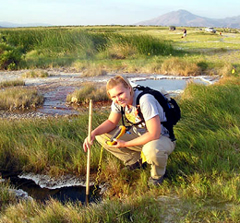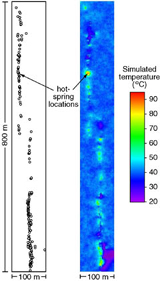Principal Investigator: Jerry Fairley (UI)
Because water brings nutrients and energy to microbial communities and controls the temperature and environment of hydrothermal springs, hydrology plays a pivotal role in linking geology, geochemistry, and microbial ecology. To understand the influence of subsurface fluid flow on microbial community development at local and micro-scales, Biocomplexity in Extreme Environments hydrogeologists are studying the transport of water, chemicals, and heat in the thermal springs of the Alvord Basin. |
 UI student measures spring temperatures near
UI student measures spring temperatures near
Borax Lake. - photo by J. Hinds |
Although the three main hydrothermal areas of the Alvord Basin (Borax Lake, Alvord Hot Springs,
and Mickey Hot Springs) are all fault-controlled and share similar aqueous chemistries, they
are located within different structural settings: the Borax Lake springs are positioned in a
kinematic (fault-trace) setting, while Alvord and Mickey Hot Springs are located in dynamic
(fault-tip interaction) zones. Because of this difference in structural setting, hydrothermal
springs in the Alvord and Mickey areas occur in discrete pods, and have relatively high mean
temperatures (~75°C) with little temporal variability. The Borax Lake thermal springs, on the
other hand, are distributed linearly along approximately 1 kilometer of the trace of the Borax
Lake fault. The Borax Lake springs are cooler on average (~58°C) than the Mickey or Alvord hot
springs, but show enormous spatial variability: two Borax Lake thermal springs, separated by as
little as one meter, can differ in temperature by more than 30°C. The extreme variations in
spring temperatures of the Borax Lake springs are believed to result from strongly-heterogeneous
permeability distributions within the fault that controls fluid flow from the geothermal
reservoir; this relationship between temperature and flow path permeability has been used by
project researchers to develop high-resolution models of permeability distributions within active
fault zones.
|
The heart of the hydrogeologic investigations of the Alvord Basin is
the detailed hydrologic characterization project, wherein the following datasets were developed (for Borax Lake and Mickey Hot Springs):
- list of thermal spring identifiers (naming convention scheme)
- maps of the thermal areas showing individual spring locations
- comprehensive record of spring temperatures
- major ion chemistries, pH, and pE for individual springs
- digital photo archive of individual springs
- high-resolution maps of ground temperatures surrounding springs
Most of the data collected in the hydrologic characterization is made available to
researchers and the general public by the Biocomplexity in Extreme Environments and the
Computational Hydrology Group at the University of Idaho to support and encourage
interdisciplinary research of hydrothermal areas in the Alvord Basin. To access the data, use the Data Resources link on this website.
|
Geostatistical simulation of temperatures in the Borax Lake fault zone.
Higher temperatures are indicated by warmer colors. The black and white image shows the locations of hot spring vents along the fault. |
|


